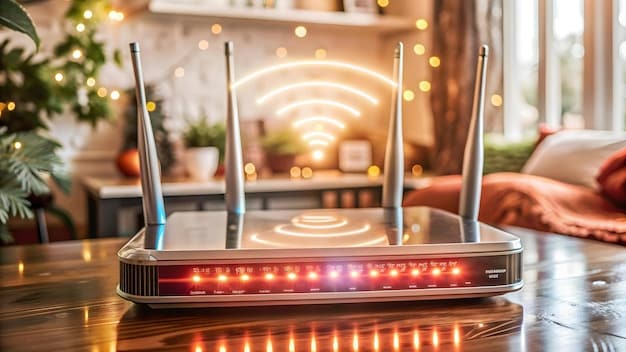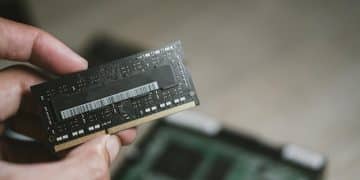Will Wi-Fi 7 Router Upgrade Boost Your Home Network Speed by 40%?

Upgrading to a Wi-Fi 7 router may not automatically guarantee a 40% increase in your home network speed, as actual improvements depend on factors like existing hardware, network congestion, and the number of connected devices, but it can significantly enhance overall performance.
Thinking about upgrading to a Wi-Fi 7 router to get that promised 40% speed boost? Let’s break down what you can realistically expect and whether it’s the right move for your home network.
Understanding Wi-Fi 7: The Next Generation of Wireless
Wi-Fi 7 is the latest iteration of wireless technology, promising faster speeds, lower latency, and improved overall performance compared to its predecessors. It uses new technologies like 320 MHz channels, 4K QAM, and Multi-Link Operation (MLO) to achieve these enhancements.
Key Features of Wi-Fi 7
Wi-Fi 7 aims to address the growing demands of modern wireless networks by introducing several key improvements. These advancements are designed to provide a more efficient and reliable wireless experience.
Here’s a closer look at some of the most significant features:
- 320 MHz Channels: Wider channels allow for more data to be transmitted simultaneously, increasing overall throughput.
- 4K QAM (Quadrature Amplitude Modulation): This technology packs more data into each signal, further boosting data rates.
- Multi-Link Operation (MLO): MLO enables devices to use multiple frequency bands simultaneously, reducing latency and improving reliability.
These features work together to provide faster and more stable wireless connections, making Wi-Fi 7 a significant upgrade for users with high bandwidth demands.
In summary, Wi-Fi 7’s suite of technological advancements promises a substantial leap forward in wireless capabilities, setting the stage for faster and more reliable connectivity in homes and offices.
The 40% Speed Increase Claim: Fact vs. Fiction
The claim that upgrading to a Wi-Fi 7 router will automatically improve your home network speed by 40% needs careful examination. While Wi-Fi 7 has the potential to deliver such gains, several factors influence real-world performance.

Factors Affecting Real-World Speed
The advertised 40% speed increase is often based on theoretical maximums. Actual speeds depend on several variables. Understanding these factors can help you manage expectations and optimize your network setup.
Here are some critical factors to consider:
- Existing Hardware: Your devices need to support Wi-Fi 7 to take full advantage of the new standard. Older devices will still connect, but they won’t benefit from the enhanced speeds.
- Network Congestion: If your network is already congested with multiple devices, the benefits of Wi-Fi 7 may be less noticeable.
- Distance from Router: Wireless signal strength decreases with distance. Being too far from the router can negate any potential speed gains.
Therefore, while upgrading to a Wi-Fi 7 router can improve speeds, the actual increase can vary widely depending on your specific circumstances. Managing expectations requires a realistic understanding of these external factors.
In conclusion, claiming a flat 40% speed increase is an oversimplification. It’s important to consider various factors to accurately gauge the potential benefits of upgrading to a Wi-Fi 7 router.
Device Compatibility: Can Your Gadgets Handle Wi-Fi 7?
One of the most critical considerations before upgrading to a Wi-Fi 7 router is whether your existing devices are compatible with the new standard. If your devices don’t support Wi-Fi 7, you won’t experience the promised speed improvements.
Assessing Your Device Ecosystem
Before investing in a Wi-Fi 7 router, take an inventory of your connected devices. Check if your smartphones, laptops, smart TVs, and other gadgets support Wi-Fi 7. This evaluation will help you determine the potential benefits of the upgrade.
- Check Device Specifications: Review the technical specifications of your devices to see if they list Wi-Fi 7 support.
- Consider Future Purchases: If you plan to buy new devices in the near future, factor in Wi-Fi 7 compatibility.
Upgrading devices to support Wi-Fi 7 can be costly. The lack of compatibility could mean you’re not getting the full value from your new router.
In summary, device compatibility is a crucial component of whether a Wi-Fi 7 upgrade is worthwhile. Without it, the advanced capabilities of the router will be underutilized.
The Impact of Network Congestion on Wi-Fi 7 Performance
Even with a Wi-Fi 7 router and compatible devices, network congestion can significantly impact performance. Wi-Fi 7 offers features to manage congestion, but these are not foolproof. Understanding how congestion affects your network is essential.

Managing Network Congestion
Wi-Fi 7 introduces technologies like Multi-Link Operation (MLO) to alleviate congestion. MLO allows devices to use multiple frequency bands simultaneously, reducing the load on any single band. However, the effectiveness of MLO depends on several factors.
Here are actions you can take to mitigate network congestion:
- Prioritize Devices: Use Quality of Service (QoS) settings to prioritize bandwidth for critical devices.
- Reduce Interference: Minimize interference from other electronic devices and neighboring wireless networks.
- Upgrade Network Infrastructure: Consider upgrading other network components, like switches and cables, to support the increased bandwidth.
Optimizing your network setup can minimize the impact of congestion and maximize the Wi-Fi 7 experience.
In short, network congestion can undermine the potential benefits of Wi-Fi 7. Effective management strategies are critical for maintaining optimal performance.
Cost-Benefit Analysis: Is a Wi-Fi 7 Router Worth the Investment?
Upgrading to a Wi-Fi 7 router represents a significant investment. Before making the leap, it’s important to weigh the costs against the potential benefits. Consider your current network needs and future requirements.
Evaluating Your Needs
Consider the following factors to determine if a Wi-Fi 7 router is a sound investment:
- Internet Speed: If your internet speed is already slow, a Wi-Fi 7 router won’t magically make it faster. The router can only distribute the bandwidth you’re already paying for.
- Number of Devices: If you have many devices competing for bandwidth, Wi-Fi 7’s congestion management features may be beneficial.
- Specific Applications: Do you need low latency for gaming or high bandwidth for streaming 4K video? Wi-Fi 7 excels in these areas.
Assessing these factors will help you determine if the benefits of Wi-Fi 7 outweigh the cost.
Ultimately, the decision to upgrade to a Wi-Fi 7 router should be based on a careful assessment of your specific needs and budget. A well-informed decision will ensure that you get the best value for your investment.
Optimizing Your Home Network for Wi-Fi 7 Performance
Once you’ve upgraded to a Wi-Fi 7 router, optimizing your home network is crucial to maximizing its performance. Proper setup and configuration can unlock the full potential of the new technology.
Best Practices for Wi-Fi 7 Setup
Here are some best practices to follow when setting up your Wi-Fi 7 router:
- Placement: Position the router in a central location, away from obstructions and interference.
- Configuration: Configure the router settings to take full advantage of Wi-Fi 7 features, such as MLO and QoS.
- Firmware Updates: Keep the router’s firmware updated to ensure optimal performance and security.
By following these steps, you can fine-tune your network for the best possible Wi-Fi 7 experience.
To summarize, optimizing your home network after upgrading to a Wi-Fi 7 router is essential. Proper setup and maintenance will ensure that you enjoy the full benefits of the new standard.
| Key Aspect | Brief Description |
|---|---|
| 🚀 Wi-Fi 7 Speed | Potential for faster speeds, but depends on multiple factors. |
| 💻 Device Compatibility | Requires devices that support Wi-Fi 7 to see benefits. |
| 🌐 Network Congestion | Can still limit performance even with Wi-Fi 7. |
| 💰 Cost-Benefit | Evaluate if the benefits outweigh the investment for your needs. |
Frequently Asked Questions (FAQ)
▼
No, the 40% increase is a theoretical maximum. Real-world speeds depend on factors such as device compatibility, network congestion, and distance from the router.
▼
Only devices that support Wi-Fi 7 will benefit from the new standard’s enhanced speeds. Older devices will still connect, but won’t be faster.
▼
MLO allows devices to use multiple frequency bands simultaneously, reducing latency and improving reliability, which helps in managing network congestion more effectively.
▼
Optimize by positioning the router centrally, configuring settings like QoS, and keeping the router’s firmware updated for the best performance and security.
▼
A Wi-Fi 7 router won’t increase your internet speed, so assess your needs. It distributes your current bandwidth more efficiently, which benefits multiple devices.
Conclusion
In conclusion, while upgrading to a Wi-Fi 7 router may offer impressive theoretical speed improvements, the actual benefits you experience in your home network depend on a variety of factors. Evaluating device compatibility, managing network congestion, and optimizing your router settings are essential steps to maximize the potential of Wi-Fi 7. Consider your specific needs and budget to determine if the upgrade is the right choice for you.





